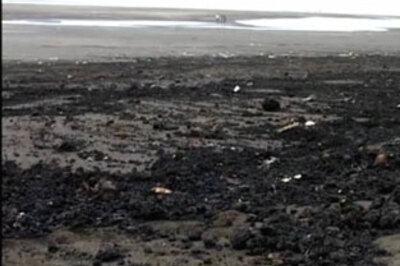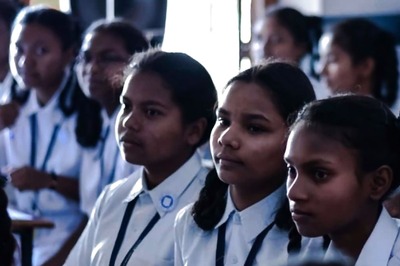
views
Chennai: Tamil makkal (people) have always held two things close to their hearts – films and politics.
Now, with superstars Rajinikanth and Kamal Haasan taking the political plunge, News18.com analyses the close-knit history behind Tamil Nadu’s two biggest obsessions.
Ever since the days of monochrome, films and politics in the southern state have been intertwined. Initially used for anti-British propaganda, the celluloid medium was then turned into furthering Dravidian agitprop by the Dravida Munnetra Kazhagam or the DMK.
Tamil Nadu’s first chief minister, CN Annadurai, along with Karunanidhi, were the first scriptwriters who pushed forth the agenda of Dravidian ideologies.
Their biggest hit was the 1952 film Parasakthi, which carried reformist views on the social hierarchy set by the caste system and glorified the movement. The film was also the debut of two other DMK founders, Sivaji Ganesan and SS Rajendran (SSR), both of whom went on to become legends of Tamil cinema.
The films were so successful in getting the message across to the people that a jittery Congress had to resort to censorship to retain its hold in the state. The cuts in the films were so severe and calculated that the end product lacked even basic continuity.
When Annadurai and Karunanidhi decided to shift their focus back to theatre, the national party ensured the Dramatic Licensing Act brought censorship to stage plays as well.
The idea, though, had been planted. The common man had been touched and films, his only source of entertainment, had become the platform from which he concocted his doctrine.
The hero worship of actors and politicians in Tamil Nadu can also be traced back to the cinema-propaganda days. As actors like Sivaji Ganesan and SSR kept the message of Dravidian movement rolling, the characters they played on screen turned them into superstars. For the largely uneducated Tamil population, the actors began to symbolise hope and aspiration. The DMK had the last laugh.
The party’s downfall, ironically, was brought about by its biggest asset at the time — MG Ramachandran. The actor was part of DMK's propaganda brigade and essayed roles of a common man who by the end of the movie would be a proverbial king.
A king never bows down to anyone and MGR, while maintaining a relationship with the party, did not attach himself too closely to it.
A growing independent popularity, Annadurai's death and Karunanidhi's open push for his first son MK Muthu led the actor to lash out against the party and subsequently form the Anna Dravida Munnetra Kazhagam (ADMK), which was later renamed to All India Anna Dravida Munnetra Kazhagam (AIADMK) in 1972.
His popularity and astute political alliances helped MGR topple the DMK during the next assembly elections in 1977, paving the way for Tamil politics to become a bipartisan, Dravidian, contest.
With Sivaji Ganesan having moved away from the DMK due to differences and SSR readily joining hands with him to play second fiddle, MGR went on to win the next three assembly elections and lead the state as its chief minister till his death in 1987. His last election, in 1984, saw the AIADMK-Congress alliance score a huge 195-seat victory. The election result proved the undying charisma of MGR upon the masses.
MGR's demise, more precisely his funeral procession, thrust the light upon another film star. Someone, who till that point seemed incapable of ever holding an administrative office – J Jayalalithaa.
A close aide, confidante and co-actor in quite a few movies of the leader, Jayalalithaa soon engineered a faction of powerful AIADMK ministers to back her claim as the next-in-line.
The next couple of years were tumultuous to the AIADMK, as the party had split into two groups. One group backed Jayalalithaa, while the others supported MGR's widow, Janaki Ramachandran.
The dust settled after the 1989 assembly elections when a 41-year-old Jayalalithaa entered the Tamil Nadu Legislative Assembly to become the leader of the opposition.
Both the AIADMK and DMK having fully realised the power of cinema up till now soon began to create their own lobbies and production houses in the Tamil film industry.
Top actors, both male and female, would have to select sides and regularly take part in photo-ops. The DMK even had actor Kumaresan Duraisamy, more popularly known as Napoleon, selected as the Minister of State for Social Justice and Empowerment in Prime Minister Manmohan Singh's UPA-II cabinet.
Others, meanwhile, decided to walk their own path into politics.
While Kamal Haasan and Rajinikanth's political foray have taken over headlines, actor Vijayakanth had created similar ripples back in 2005.
Having been disenchanted with the two Dravidian parties and their "corrupt ways", Vijayakanth launched Desiya Murpokku Dravida Kazhagam (DMDK), a regional political party with center-left ideologies. He placed his party as an alternative to the two mainstream ones.
The DMDK contested the 2006 assembly elections and went on to garner 10% of voters in the assembly elections and 10.1% votes in the Lok Sabha elections. The one-year-old outfit had just become the third largest party in the state and had managed to bring in more votes than the mighty DMK.
In 2011, Vijayakanth's party joined hands with the AIADMK and won 29 of the 41 seats it contested in. Furthermore, the actor was then elected as the leader of the opposition in the legislative assembly of Tamil Nadu.
On the other hand, after stints with both AIADMK and DMK for more than a decade, actor R Sarath Kumar launched his own political party – All India Samathuva Makkal Katchi in 2007. The party has not seen much success other than the two assembly seats it had won in alliance with the AIADMK in 2011.
While many disapprove of art and entertainment being used to further an ideology, it remains an inescapable truth that both co-exists and will influence each other.


















Comments
0 comment